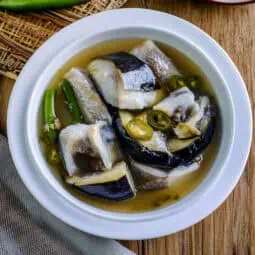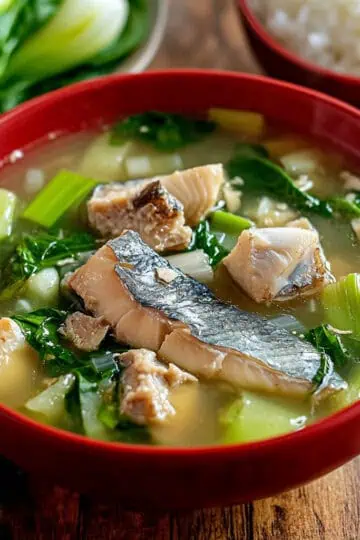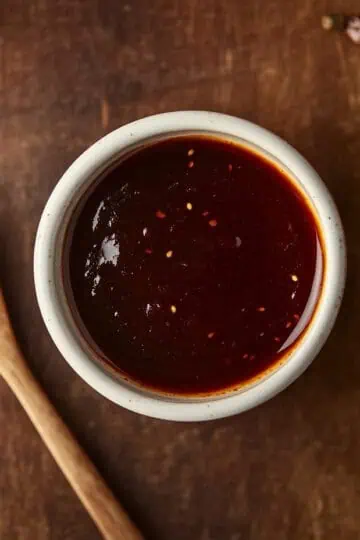I've always struggled with getting my kids to eat fish that wasn't crispy-fried. That was until I perfected this Paksiw na Bangus recipe, a dish that completely changed their minds about non-fried fish.
The perfectly balanced tangy sauce that's not too sour (thanks to my Lola's trick of adding a touch of oil at the end), tender fish that practically melts in your mouth, and the familiar comfort of seeing it regularly on our table, just like in my own childhood.
This traditional Filipino dish has become our family's go-to weekday meal, not just because it's incredibly easy to make with simple pantry ingredients, but also because one pot can last for several meals. It tastes even better the next day.
If you're looking for an authentic, no-fuss bangus recipe that might just convert your picky eaters, too, this time-tested version is exactly what you need.
Jump to:

Why You'll Love This Recipe
- Perfectly Balanced Flavors: The tangy vinegar broth is expertly balanced with a touch of oil, creating a harmonious blend that's not too acidic
- Health Benefits: Rich in omega-3 fatty acids, protein, and essential nutrients
- Budget-Friendly: Uses affordable ingredients while delivering premium taste
- Make-Ahead Friendly: Tastes even better the next day
- Versatile Leftovers: Can be transformed into other dishes like pritong paksiw
Ingredients
This recipe uses a perfect balance of traditional Filipino ingredients that complement each other beautifully. The milkfish, with its tender flesh, absorbs the tangy vinegar broth while remaining delicate.
Ginger and garlic create an aromatic base that reduces fishiness and adds depth. Eggplant provides a soft texture that soaks up the flavorful sauce. The chilies add a gentle heat that enhances rather than overwhelms.
Finally, the special touch of oil at the end rounds out the acidity from the vinegar, creating a harmonious balance that makes this dish both comforting and distinctively Filipino.
These ingredients have been paired together for generations because they create a perfect symphony of flavors that taste even better the next day.

- 1 large bangus (milkfish), about 1 kg
- 1 large talong (eggplant), cut into 1-inch wedges
- 1 medium sibuyas (onion), thinly sliced
- 4 butil ng bawang (garlic cloves), crushed
- 1 thumb-sized luya (ginger), crushed
- 3-4 siling haba (finger chilies)
- 1½ teaspoons asin (salt)
- 1 teaspoon pamintang buo (whole peppercorns)
- ½ cup suka (white vinegar)
- 1 cup tubig (water)
- 1 tablespoon mantika (cooking oil)
Equipment
- Large kawali (wok) or deep pan - For even heat distribution to ensure the fish cooks evenly without breaking apart
- Sharp knife - For cleaning fish and cutting vegetables precisely
- Wooden spoon - For gentle stirring without breaking the fish
- Measuring cups and spoons - For accurate ingredient measurements
- Small bowl - For preparing spices before adding to the main dish
- Cutting board - For safely preparing ingredients

How To Make
- First, start by cleaning the bangus. Remove the innards and gently wash the fish, keeping the scales on if you prefer. Cut the fish crosswise into 2-inch thick slices.
- Crush 4 cloves of garlic and slice one thumb-sized piece of ginger into strips. Cut one large eggplant into 1-inch thick wedges. Slice one onion thinly.
- Take your cooking pot or kawali and layer the sliced onions, crushed garlic, and ginger strips at the bottom.
- Place the bangus pieces on top of these aromatics. Try not to stack or overlap the fish pieces. Arrange the eggplant wedges and finger chilies around the fish.
- Pour ½ cup vinegar and 1 cup water over everything. Add 1½ teaspoons salt and 1 teaspoon whole peppercorns. Do not stir.
- Turn the heat to high and let it come to a boil. Once boiling, lower the heat and cover the pot. Let it simmer gently for 15 minutes. Remember not to stir, as this will break the fish.
- After 15 minutes, check if the fish is cooked through. The flesh should be opaque and flaky.
- Here's the special step that makes this recipe perfect: drizzle 1 teaspoon of cooking oil over the top. Instead of stirring, gently shake the pot to spread the oil.
- Let everything simmer for 2-3 more minutes, then turn off the heat. Let it rest for 5 minutes before serving.
- Serve hot with rice and fish sauce on the side.

Tips from Lola's Kitchen
- Never stir until fully cooked: This keeps the fish pieces intact and prevents them from breaking apart during cooking.
- Add a touch of oil at the end: This is the secret to balancing the acidity of the vinegar and creating a more rounded flavor profile.
- Keep the scales on: The scales help protect the fish while cooking and create a pleasant gelatinous texture many Filipinos love.
- Use clay pot if available: A traditional palayok (clay pot) imparts a subtle earthy flavor that enhances the dish.
- Add taro for thickening: Gabi (taro) can be added to naturally thicken the sauce without changing the flavor profile.
- Let it rest after cooking: Allow the dish to sit for 5-10 minutes after cooking for the flavors to fully develop.
Substitutions
- Fish options: If bangus isn't available, you can use tulingan (mackerel) or tambakol (skipjack tuna) instead.
- Vinegar varieties: While white vinegar is traditional, apple cider vinegar can work (use slightly less) or cane vinegar for a milder taste.
- Vegetable alternatives: Replace eggplant with okra, ampalaya (bitter gourd), or sayote (chayote) based on preference.
- Ginger substitute: If fresh ginger is unavailable, use 1 teaspoon of ginger powder, though fresh is always preferred.
- Chili options: Adjust the heat level by using bird's eye chilies for more spice or bell peppers for a milder version.
Troubleshooting
- Too sour? Add a small potato while cooking to absorb excess acidity, or add a half teaspoon of sugar to balance the flavors.
- Fish breaking apart? Ensure your liquid is gently simmering, not rapidly boiling. Also, avoid stirring until the fish is fully cooked.
- Too salty? Add sliced green papaya or a bit more water to balance the salt level.
- Too watery? Simmer uncovered for an additional 5 minutes to reduce the liquid and concentrate flavors.
- Fishy smell too strong? Add more ginger and ensure you're using the freshest fish possible. A squeeze of calamansi or lemon can also help.
Storage & Reheating
- Refrigeration: Store in an airtight container for up to 3 days. The flavors actually improve overnight!
- Freezing: Not recommended as the texture of the fish changes significantly when frozen.
- Reheating on stovetop: Place in a pan over low heat, covered, for 5-7 minutes until thoroughly heated. Add a splash of water if needed.
- Microwave reheating: Heat in 2-minute intervals at medium power until reaching 165°F (74°C), being careful not to overcook.
- Serving leftover paksiw: Consider transforming leftovers into pritong paksiw by lightly frying the fish pieces for a new texture.

FAQ
Why keep the scales on the bangus?
The scales help keep the fish intact during cooking and create a gelatinous texture that many Filipinos prefer. They also prevent the fish from sticking to the pan.
Can I make this dish in advance?
Absolutely! Many believe paksiw tastes even better the next day as the flavors develop and intensify overnight.
How do I reduce the fishy smell?
Add more ginger to the recipe and ensure you're using the freshest fish possible. A quick rinse with calamansi or lemon juice before cooking can also help.
Can I reuse the sauce?
Yes, the flavorful sauce can be used as a base for other paksiw dishes within 24 hours if refrigerated properly.
Is this dish safe for children?
Yes, just adjust the number of chilies based on your children's spice tolerance. The vinegar makes this dish safe as it naturally preserves the fish.
What's the best type of vinegar to use?
Traditional sukang paombong (nipa palm vinegar) gives the most authentic flavor, but any good quality white vinegar works well.
Can I add more vegetables?
Certainly! Traditional additions include sitaw (string beans), okra, or ampalaya (bitter gourd) based on regional preferences.
Related
Looking for other recipes like this? Try these:

Paksiw na Bangus (Filipino Milkfish in Vinegar Stew)
Equipment
- Large kawali (wok) or deep pan (for even heat distribution)
- Sharp knife (for cleaning fish and cutting vegetables)
- Wooden spoon (pamhalo/for gentle stirring without breaking the fish)
- Measuring cups and spoons (Panukat)
- Small bowl (for preparing spices)
- Cutting board (Sangkalan)
Ingredients
- 1 large bangus milkfish/Chanos chanos, about 1 kg
- 1 large talong eggplant/Solanum melongena, cut into 1-inch wedges
- 1 medium sibuyas onion, thinly sliced
- 4 butil ng bawang garlic cloves, crushed
- 1 thumb-sized luya ginger, crushed
- 3-4 siling haba finger chilies
- 1½ teaspoons asin salt
- 1 teaspoon pamintang buo whole peppercorns
- ½ cup suka white vinegar
- 1 cup tubig water
- 1 tablespoon mantika cooking oil
Instructions
- First, start by cleaning the bangus. Remove the innards and gently wash the fish, keeping the scales on if you prefer. Cut the fish crosswise into 2-inch thick slices.
- Crush 4 cloves of garlic and slice one thumb-sized piece of ginger into strips. Cut one large eggplant into 1-inch thick wedges. Slice one onion thinly.
- Take your cooking pot or kawali and layer the sliced onions, crushed garlic, and ginger strips at the bottom.
- Place the bangus pieces on top of these aromatics. Try not to stack or overlap the fish pieces. Arrange the eggplant wedges and finger chilies around the fish.
- Pour ½ cup vinegar and 1 cup water over everything. Add 1½ teaspoons salt and 1 teaspoon whole peppercorns. Do not stir.
- Turn the heat to high and let it come to a boil. Once boiling, lower the heat and cover the pot. Let it simmer gently for 15 minutes. Remember not to stir, as this will break the fish.
- After 15 minutes, check if the fish is cooked through. The flesh should be opaque and flaky.
- Here's the special step that makes this recipe perfect: drizzle 1 teaspoon of cooking oil over the top. Instead of stirring, gently shake the pot to spread the oil.
- Let everything simmer for 2-3 more minutes, then turn off the heat. Let it rest for 5 minutes before serving.
- Serve hot with rice and fish sauce on the side. This dish tastes even better the next day, after the flavors have had time to develop.
Tips from Lola's Kitchen
- Never stir paksiw until fully cooked to keep the fish intact
- Add gabi (taro) for natural thickening
- Use native sukang paombong for authentic taste
- Cook in palayok (clay pot) for traditional earthy flavor
- Keep scales on for a gelatinous texture
Nutrition
The Story Behind Paksiw na Bangus
In the heart of Filipino cuisine lies Paksiw na Bangus, a dish that perfectly embodies our ancestors' ingenuity in preserving food before the era of refrigeration. This traditional cooking method, which comes from the word "paksiw" - meaning to cook in vinegar - dates back to pre-colonial Philippines, where our forebears discovered that vinegar not only enhanced flavor but also extended the shelf life of fish in our tropical climate.
Bangus, or milkfish, became the star of this preparation technique largely due to its abundance in both Philippine waters and fishponds across the country. Known as our national fish, bangus has been cultivated in the Philippines for over 800 years, with evidence of early fishponds dating back to the 15th century. The practice of cooking it in vinegar emerged naturally, as fishermen and their families sought ways to preserve their bountiful catch.
What makes Paksiw na Bangus particularly special is its regional variations across the Philippines. In Pangasinan, where some of the country's largest bangus fishponds are located, they prefer their paksiw with plenty of ginger and minimal water. The Bicolanos sometimes add gata (coconut milk) to their version, while in the Visayas, the dish often includes more vegetables like ampalaya or okra. Despite these variations, the core combination of vinegar, ginger, and garlic remains constant, creating that distinctively Filipino sour-savory profile that we've all grown to love.
Today, this humble dish continues to grace Filipino tables worldwide, beloved not just for its practicality but also for its ability to evoke memories of home. Whether served for breakfast with sinangag (garlic rice), packed in baon (packed lunch), or enjoyed as ulam (viand) for dinner, Paksiw na Bangus stands as a testament to our culture's resourcefulness and our deep connection to the sea. Its enduring popularity also speaks to how our traditional cooking methods remain relevant in modern times, offering a healthy, sustainable, and delicious way to prepare fish that's been passed down through generations of Filipino families.










Comments
No Comments